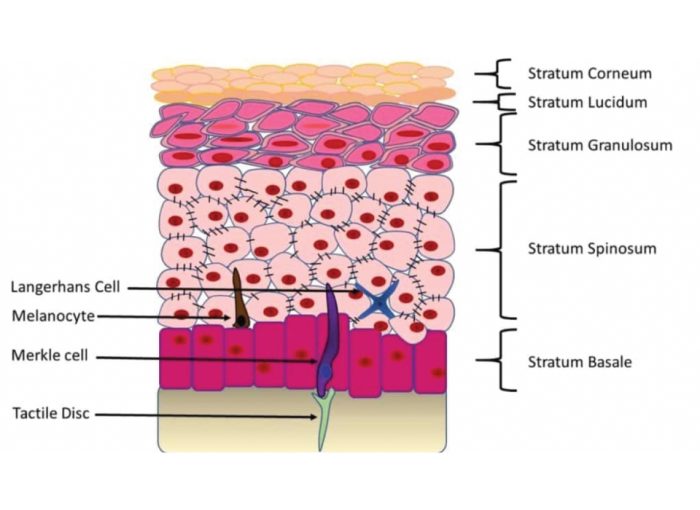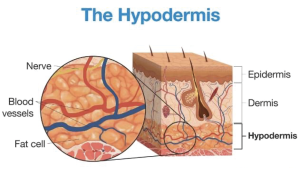Understanding the Skin
What is the skin?
The skin is the largest organ in the body and covers an area of almost 2 square meters. It has varying thickness throughout the body, where some areas have much thinner skin, like the eyelids, and thicker skin like the skin on the back.
The skin is made up of water, protein, cholesterol, lipids, fats, minerals, and amino acids and functions as a barrier against outside aggressors, germs, and other microbes. Other functions include;
- Thermoregulation
- Sensory organ
- Protective shield against UV rays
- Stores water and fats
- Prevents water loss (Trans epidermal loss)
- Helps make Vitamin D from the sun
The colour of the skin is determined by specific pigment producing cells called Melanocytes found in the outermost layer of the skin.

The skin is made up of three layers;
1. The epidermis – The visible outermost layer which is the most protective barrier from outside aggressors.
2. The dermis – the middle layers of the skin where connective tissue hair follicles, and sweat glands are found.
3. The hypodermis – the innermost layer found deep within the skin, containing connective tissue and fat, also known as the subcutaneous layer.
| Function | Effect on Skin |
|---|---|
| Outermost layer of the skin | Provides a physical barrier to the outside environment. |
| No blood vessels found in this layer | Depends on nutrient delivery from the Dermis. |
| Act as a physical barrier to the outside environment | Waterproof barrier that protects the underlying skin. |
| Waterproof barrier that protects the underlying skin | Prevents irritants like bacteria, viruses, and allergens from entering the body. |
| Prevents irritants like bacteria, viruses, and allergens from entering the body |

- Keratinocytes
- forms a tough protein called Keratin which gives skin permeability, making it insoluble, and providing flexibility and strength.
- Melanocytes
- Are responsible for UV protection of the skin and produces pigment in the skin.
- Merkel Cells
- Are responsible for the sensation of light touch.
- Langerhans Cells
- Activates the immune response in the body.
- The Epidermis is composed of 4 layers (Areas of thicker skin have 5 layers)
- Stratum Corneum – horny layer (dead and dry)
- Stratum Lucidum – only found in areas of thicker skin (palms of hands, soles of feet)
- Stratum Granulosum – granular layer
- Stratum Spinosum – prickle cell layer
- Stratum Basale – germinative layer
Stratum Corneum
Is known as the horny layer, as the cells are dead, hard and stick out. This layer can be around 20 layers thick while areas like the eyelids have fewer layers. The cells that make up this layer are called corneocytes and they can swell and retain water, due to natural moisturising factors (NMF) which are found in this layer of the skin. This keeps the skin pliable and elastic preventing cracks and scratches. When this barrier is disturbed, the skin loses moisture and can lead to dehydration. Most moisturisers do their magic in this layer, to help attract and trap moisture to plump and smooth skin.
Shedding
Shedding is also known as desquamation, which is the process of the skin losing individual dead skin cells. The process of desquamation occurs naturally in healthy skin at all ages. However, it can become impaired with ageing, acne (the follicles), sun damage and certain skin diseases. For this natural process to occur there has to be sufficient water in the stratum corneum and the surface pH needs to be acidic (the acid mantle). When shedding is impaired (not happening fast enough) the skin will look dull in complexion, have poor texture, have increased fine lines and wrinkles and result in skincare and makeup applying poorly.
Lipid Bilayer
The lipid bilayer is the most important component for retaining water in the skin. The lipid bilayer is made up of cholesterol, free fatty acids and ceramides, mixed together to form a specialised water trapping layer in the stratum corneum. If this layer is absent or poorly formed, the skin loses excesses water and becomes red, dry, uncomfortable, and flaky. Fixing the lipid bilayer is THE most important step in restoring healthy skin, giving relief to dry skin sufferers.
Acid Mantle
The acid mantle describes the acidic nature of the outer layer of skin. Healthy skin is acidic (pH 0 – 6) and dry diseased skin is alkaline (pH 7 – 14). This acid mantle is created by components from inside the stratum corneum and is critical to maintain normal desquamation and protection against bacterial growth in the skin. This is partly why fruit acids can be very good for the skin to help maintain the acid mantle pH. If the acid mantle is not intact skincare products can sometimes sting or burn skin. This tells you that the acid mantle is not working and that the skin is likely to be dry and have sensitivity to products.
Stratum Basale
Also known as the Stratum Germinativum, it is the deepest layer of the Epidermis and is made up of cells that are constantly producing keratinocytes. Melanocytes, which produce melanin, are also found here. It is in this layer that cell turn-over occurs. The cells start out as full, thick, and healthy cells which contains a nucleus, the powerhouse of the cell. As the development of new cells continuously occurs, the top layer moves towards to the epidermis, flattening the top layer of cells and making them more irregular in shape. The cells eventually lose their nucleus and die off. Once these cells reach the stratum corneum, the skin naturally sheds them in a process known as desquamation (shedding / cell turnover) and can take between 28 – 30 days to complete a cycle, in healthy skin. It takes two full skin cell turnover cycles to start seeing results from product application. (A minimum of 8 weeks)
The Dermis Layer
The dermis is connected to the Epidermis at the basement membrane and contains the sweat gland, hair, hair follicles, muscles, sensory neurons, and blood vessels. This layer of the skin consists of 2 layers of connective tissue: the papillary layer and the reticular layer. The dermis is the most important layer when it comes to customer expectations as this layer relates to collagen, elastin, sun damage and dilated capillaries. Damage to this layer is ultimately what makes an individual look older. Fixing this layer is the most important part in anti-ageing skin program. This layer also contains sensory nerve fibers, sweat glands and hair follicles.
Specific ingredients work in the dermis, such as small particle Hyaluronic Acid, Peptides, Retinoids, Vitamin C, Centella Asiatica and antioxidants. This layer contains the most important anti-ageing cells called fibroblasts. These produce new collagen and elastin. These cells reduce in functioning from the age of thirty and continue to deteriorate in functioning with age.

The Hypodermis Layer
The hypodermis, also known as the Subcutaneous Layer, is the deepest layer of the skin lying below the Dermis. This provides the main structure support for the skin, insulates the body from cold, and acts as a shock absorber for the body. It contains blood vessels, nerves, connective tissue, fibroblasts, and macrophages which keep the body free from intruders, and is mostly made up of fat. The
thickness of this layer can help distinguish men from women, where it is thickest in the abdomen and shoulders in men, it is thicker on the hips, thighs and buttocks in women. When it comes to the face, the hypodermis gives the face shape. With age, this gets thinner, and the face loses vital facial fat.
Specific ingredients work in the dermis, such as small particle Hyaluronic Acid, Peptides, Retinoids, Vitamin C, Centella Asiatica and antioxidants. This layer contains the most important anti-ageing cells called fibroblasts. These produce new collagen and elastin. These cells reduce in functioning from the age of thirty and continue to deteriorate in functioning with age.









